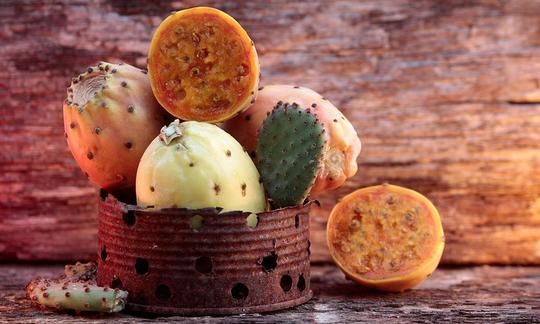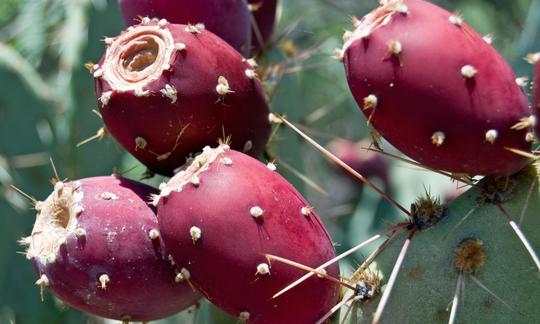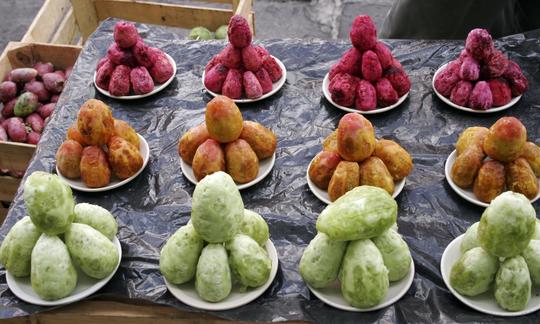Table of contents
The prickly pear, also called prickly pear or prickly fruit, grows on the useful Opuntia ficus-indica, the Opuntia cactus plant. Despite its prickly appearance, it is a sweet delicacy, especially when eaten raw.
Use in the kitchen:
What is a prickly pear? The prickly pear is an oval fruit about 5-8 centimeters in size. Depending on the type or variety, the warty skin is green, yellowish, salmon-colored or red-brown when ripe. The color of the flesh is often not the same as that of the inedible, relatively thick skin, measuring 3-5 mm.
The taste of the prickly pear is sweet with slightly sour notes. The soft flesh is similar to that of a melon and very refreshing. The color of the flesh is bright yellow, orange or red and is difficult to remove from clothes. Prickly pears taste like a combination of melon, pear and fig, but are also reminiscent of cucumber. The flesh of the prickly fruit contains edible seeds the size of peppercorns.
The shell is not poisonous, but it has fine, barely visible barbed spines. You should not touch the untreated shell without protection, as the very fine spines can remain unpleasantly in the skin for days. Tweezers and patience can help - or gently wiping them off with adhesive tape.
How can you avoid contact with the spines? The easiest way to prepare the fruit is to prick it with a fork. Cut off the top and bottom of the fruit, make another cut across to the flesh and then roll off the soft skin with a knife. A slightly more complicated way is to stand the prickly pear upright and remove the thick skin from top to bottom with a knife.
You can also wear gloves to handle the fruit. It is advisable to remove the barbs from the prickly pear with a brush. This is a laborious job, so when buying it, make sure that you buy the fruit without glochidia (barbed spines).
After removing the peel, all you have left is the wonderful flesh of the cactus pear, which you can cut into cubes and process further - or eat as is with a fork and knife.
The flesh of the prickly fruit can be eaten raw, pureed, blanched or boiled. The raw flesh, cut into cubes, gives a fresh fruit salad an exotic note. Boiled flesh makes fine chutneys or jams. If you boil the juice together with the juice of citrus fruits, you get an even more aromatic, sweet and sour sauce that can be used for a vinaigrette or for special salad dressings.
The fruit is also suitable for making thirst-quenching drinks. The juice flavors many sweets and desserts, cocktails and creams, and even beer (see below). The prickly pear can be used almost anywhere instead of cucumbers. This includes salads. 1 Prickly pears can be prepared on the grill like potatoes. Place them on the edge of the embers and let the skin char. This gives the flesh a wonderful, caramelized flavor.
Plant segments, especially young shoots, can be harvested at any time, but they are not edible raw and must be cooked.
Recipes with prickly pears:
In Mexico and Central America, the leaves of the cactus are also cooked and eaten as a vegetable (nopalitos). Recipe for nopalitos: Remove the spines, cut the shoots into strips and steam them in salt water.
Rumtopf with prickly pears is a popular recipe in South America. There, prickly pears are mixed with exotic fruits such as pineapple, mango, lychee or kumquat (dwarf orange). In Europe, pears are also used.
Vegan recipe for prickly pear jam:
Especially in areas where you can harvest prickly pears as they are, it is worth making a tasty jam from them if you cannot eat them raw within a reasonable time. For 3 kg of prickly pears, use 1 kg of gelling sugar and the juice of two lemons or, even better, three to four limes. The gelling sugar must not be past its expiration date if you want to use it to shorten the cooking time. Preserving sugar does not contain any gelling agents.
After removing the spines (glochidia or glochids) and peeling, mash ripe fruit with a fork or cut harder prickly pears into small cubes. Add the gelling sugar, mix well and leave to steep for at least two hours (or overnight). Then add the lemon or lime juice and boil the whole thing for 3 minutes until it bubbles. Separate the mixture from the seeds using a sieve, as they are not welcome in jam.
Immediately pour the jam into preserving jars or jam jars that have been rinsed with hot water, close them and turn them upside down for five minutes. Leaving them for longer is pointless because the contents could stick to the lid. The heat from the fruit puree will kill any germs that may still be on the top edge of the jar and on the lid. However, this is not necessary if you pretreat them properly. You can pretreat them, for example, by heating them in an oven or a preserving pan, with the sealed jars standing upright and exposed to 80°C for an hour.
| Not only vegans or vegetarians should read this: Vegans often eat unhealthily. Avoidable nutritional errors. |
Shopping - where to buy?
Prickly pears are available almost all year round in North America and Europe from specialty fruit dealers, delicatessens and Asian shops. Supermarkets and wholesalers such as Coop, Migros, Denner, Volg, Spar, Aldi, Lidl, Rewe, Edeka, Hofer etc. sell prickly pears at least during the high season. Compare the quality in organic shops and health food stores. Make sure that there are no injuries or even rotten spots at the break point, because the fruit has to be twisted off when picking.
You can also buy prickly pear juice there or in drugstores. This is a fine drink with a revitalizing effect. The juice can also be bought as a liqueur. You can also find dried, chip-like prickly pears, which are good as a snack. You can also make tea from the flowers.
The season for cactus fruit in the northern hemisphere varies greatly depending on the zone. In Italy and Tunisia, it can begin in July and lasts from August to December in Spain. In Peru, on the other hand, the ripe fruit is available from November to April and in Brazil, Colombia and Mexico, ripe fruit is sold all year round.
What does a ripe prickly pear look like? The color of the prickly pear does not depend on the ripeness of the fruit. Since the prickly pear does not ripen, it should be a little soft when you buy it. If the flesh gives way when gently pressed and the fruit smells aromatic, it is ripe. Fruit that is harvested too early tastes bland.
How heavy is a cactus fruit on average? The fruits vary quite a bit in size and the pulp weighs about 100 to 150 g per fruit.
Found in the wild:
The common prickly pear cactus is found in the wild in warmer areas and in the subtropics worldwide. In Europe it can be found in the Mediterranean and in dry areas. Like most cacti, it thrives in extreme sunlight on nutrient-poor soil. It can easily withstand 2 to 3 years of drought and can still produce fruit. The prickly pear cactus has been used as food for thousands of years. 2 Its extensive root system allows it to hold the soil firmly. As windbreak hedges, the plate-shaped cacti counteract soil erosion. The prickly pear cactus helps to protect the desert fringe zones.
Storage:
The ripe cactus fruits cannot be stored for too long. They will last a few days in the fridge. To ensure that their aroma develops properly, it is important to take them out about an hour before eating. They will then not taste icy because of their high water content.
Ingredients - nutritional value - calories:
Which vitamins are in the prickly pear? The flesh of the prickly pear does not contain many vitamins: mainly vitamin C, but with 14 mg/100g it is about four times less than in strawberries with 59 mg (lemons contain about 50 mg). Other vitamins that are just about worth mentioning are riboflavin (vitamin B2), pyridoxine (vitamin B6), niacin (ex. vitamin B3) and folic acid. At most traces of vitamin E and beta-carotene (precursor of vitamin A) are contained.
Magnesium is present at 85 mg/100g, which is in the middle range, as you would only cover your daily requirement with 400 to 500 g. Peeled hemp seeds, however, contain nine times more of it. Beans have eight times more of the mineral potassium (220 mg). The calcium (56 mg) covers 7% of the daily requirement per 100 g and the phosphorus (24 mg) only 3%. On the other hand, the amount of fiber in the prickly fruit is considerable. It contains practically no fat and only around 40 calories per 100 grams.
If you compare the ingredients with the energy, a much better picture emerges: 100 g of prickly pears cover 2% of the daily calorie intake. The unpeeled lemon only has 1.4%, but as mentioned above, it is clearly superior in terms of vitamin C content (although not the strongest representative of vitamin C, more on this under the ingredient lemon).
Health aspects - effects:
How healthy is the prickly pear? If you read other websites, you could call the prickly pear a superfood - in the original it sounds something like this: The high vitamin C content of the prickly pear protects the immune system when eaten raw. Just one fruit covers around a quarter of our daily vitamin C requirement. Beta-carotene is important for the eyes 3 and the immune system. Vitamin E is a cell-protecting vitamin and has an antioxidant effect. The reality is different, however - as mentioned above with vitamin C.
Yes, the fiber improves the intestinal flora and promotes intestinal transit. But then you keep reading truisms like: potassium helps regulate blood pressure and is especially important for the heart and coronary arteries. Potassium also helps replenish the body's mineral content when you are convalescing. Magnesium is also essential for heart function and helps control the muscles and nerves. The minerals phosphorus and calcium together are a very important component of bones and teeth.
Folate is involved in the body's growth process, cell division and blood formation. 4 The antioxidants in the prickly pear are said to have a cancer-preventing effect. This exotic fruit has also been shown to thin the blood. 5
The high fruit sugar content (fructose and glucose in equal parts) improves the absorption of nutrients in the body. The prickly pear is one of the types of fruit that is said to regulate sugar metabolism. The fruit has a low glycemic value and is also very rich in fiber, which slows down the absorption of sugar. 6
Can you lose weight with prickly pears? Prickly pears can only contribute a little to weight loss, but they do promote natural eating. It is certain that the extract from the nopal cactus has a blood sugar-lowering effect. In concrete terms, this means that it can reduce high blood sugar levels in type 1 diabetes. This is a chronic disorder of the sugar metabolism that causes blood sugar levels to rise. Nopal has also been proven to work in type 2 diabetes. 7,8 The genus name Nopalea is a synonym for Opuntia : a nopal cactus is therefore the same as an Opuntia.
Dangers - Intolerances - Side effects:
People who take blood-thinning medication should be careful when eating prickly pears, as these have been shown to have a blood-thinning effect. The oxalate crystals can cause some people to experience a slight burning sensation on the tongue or the urine can turn reddish. This is not a problem and will pass. 9
Use as a medicinal plant:
The prickly pear cactus has always been a medicinal plant of the Indians. It has a high proportion of pectin. This destroys the harmful LDL cholesterol and strengthens the protective, good HDL cholesterol. This is what nutritionists at the University of Arizona report. They have also proven that the cactus can reduce high triglyceride levels (blood fats). 10
Alpha-1 blockers from the plant (not the fruit) dock onto the alpha-1 receptors in the bladder and can relax them in order to relieve bladder weakness. In addition, at least in the case of Opuntia vulgaris, there are phytosterols, e.g. beta-sitosterol, in the plant. This substance is used, among other things, for benign prostatic hyperplasia (benign enlargement of the prostate).
Folk medicine - natural medicine:
Even today, the effect of the prickly pear cactus is still used in folk medicine to treat diabetes. Its extract lowers high blood sugar levels and can be a good support for medical treatment. Recently, prickly pears have also been gaining increasing attention in Europe as a modern and promising dietary supplement thanks to their remarkable ingredients. 11 The Aztecs used a recipe with prickly pear juice to treat burns.
Occurrence - Origin:
In the 16th century, sailors brought the tropical prickly pear to the Mediterranean. Today, the second largest production site is said to be around the volcano Etna in Sicily. The yellowish-orange fruit is mainly grown here. It is followed by South Africa, Chile and Argentina. 12,13 Other countries deliver these exotic items all over the world at different times.
The prickly pear cactus ( Opuntia ficus-indica) is a plant species from the cactus family. They are sprawling water reservoirs that grow like shrubs to a height of 4 to 8 meters. The prickly pears grow from fertilized flowers on their areoles (short shoots). The prickly pear cactus thrives in all tropical and subtropical climates, and some cacti also thrive in temperate climates.
Growing in the garden or as a potted plant:
Before the Second World War, the prickly pear cactus was a popular potted plant in Western Europe (not in Germany) because it is easy to keep. The plant needs a lot of sunshine and can also thrive outside in the summer, e.g. on the balcony or terrace. However, it should not be left out in the rain.
The winter temperature should not rise above 6 °C and should not fall below freezing. In this case, a cellar is sufficient. The soil should be sandy, especially at the bottom, and there should be no standing water. A hole in the pot is a must. You can get advice from garden retailers - also online. The Opuntia ficus-indica only bears fruit when it is about 150 cm tall.
Cultivation - Harvest:
The prickly pears have different flavors depending on the variety. 14 The fruit is harvested in different ripening zones at different times. The fruit pickers have a tough job because they twist the fruit off the cacti, some of which are as big as trees. The fruit suffers if the break point cracks and can spoil more quickly.
Danger of confusion:
The Opuntia humifusa can easily be confused with the prickly pear plant ( Opuntia ficus-indica). This is an almost horizontal type of prickly pear with edible prickly pears and has eleven different synonyms. It grows with and without (long) thorns. The plants bloom with mostly yellow flowers from June to July and later produce reddish fruits. In America, the Opuntia humifusa is found from the Canadian border to northern Mexico and the Plains Indians of the Dakota and Pawnee tribes use its peeled shoots to treat wounds. According to Wikipedia, the Lakota use it to treat snake bites and the Nanticoke use it to heal warts. Naturalized in Europe, the Opuntia humifusa is hardy and grows even in the Swiss Alps, where the winter is not too wet, in sunny locations with permeable soil, and can withstand temperatures as low as -30 °C. 18
Opuntia fragilis, which can be found a little further north, has a similar growth pattern. Wikipedia: The Okanagan and the Secwepemc make a poultice from Opuntia fragilis to treat sore throats and other pains. They eat the shoots as a diuretic.
Animal protection - species protection - animal welfare:
According to the specialist journal Environmental Science & Technology, the use of prickly pear cactus flesh is said to be effective in purifying drinking water containing arsenic - with the same effect as chemical additives. This is, for example, much more effective than using iron salt alone. Be careful: As a houseplant, the prickly pear cactus is considered a food plant for certain pets, eg certain turtles. Bees usually pollinate the prickly pear cactus (and other hymenoptera and beetles as well).
General information:
Prickly pears ( Opuntia ficus-indica) are not figs, but belong to the cactus family (Cactaceae). Figs, on the other hand, belong to the mulberry family (Moraceae). The Opuntia ficus-indica is the only type of prickly pear that is cultivated in the Mediterranean region. 15 The fruit is a berry. According to Wikipedia, the prickly pear cactus originally comes from Mexico. 19 Prickly pears can also be easily propagated vegetatively.
In Morocco, prickly pear oil is produced in a very complex process. The oil pressed from the seeds of the prickly pear is of a noble, golden yellow color. One tonne of figs is needed to produce one litre of oil. 16 It is therefore a very expensive oil.
The cactus society of the three German-speaking countries Germany, Austria and Switzerland (DACH) chose the prickly pear as the cactus of the year 2019. 19 In the same year, a brewery in Germany launched a beer mixed with 50% wheat beer and 50% prickly pear soft drink. The beer actually only has 1.6% prickly pear juice but the beer is supposed to have an exotic, tart tingle.
Alternative names:
The prickly pear is not only called prickly pear, prickly fig, prickly pear or prickly fruit, but also opuntia and nopal cactus - and there are numerous synonyms for the Latin name. In English the fruits are called prickly pears (Indian fig opuntia, Barbary fig, cactus pear, and spineless cactus), in Spanish the fruit is called tuna (also higo chumbo), the plant is called nopal. But on the Canary Islands the fruit is called higo pico.
The cactus was at least previously cultivated mainly on the Canary Islands for the purpose of breeding the scarlet or nopal scale insect (cochineal aphid). It can also be found everywhere in the wild. The white scale insect was often used to produce the red color carmine for lipstick. Carmine red (mostly from Peru) is available under E 120 as an approved food coloring. But carmine is also important for use in colored drinks (Campari) or in sweets. 17 The cochineal scale insect can be bred on the species Opuntia atropes, Opuntia cochenillifera, Opuntia ficus-indica, Opuntia hyptiacantha, Opuntia jaliscana, Opuntia megacantha, Opuntia pilifera and Opuntia tomentosa. 20
Literature - Sources:
Bibliography - 20 Sources
| 1. | Vilgis TA, Vierich TA. Aroma Gemüse. Der Weg zum perfekten Geschmack. Stiftung Warentest; 2017. |
| 2. | Brücher H. Tropische Nutzpflanzen. Berlin:Springer-Verlag;1977. |
| 3. | Pro-retina.de Wissenschaftliche Beratungsgremien. |
| 4. | Apotheken Umschau Kaktursfeige. |
| 5. | Wolfram R, Budinky A et al. Daily prickly pear consumption improves platelet function. PubMed. Jul;2003. |
| 6. | Gesundheit.com Kaktusfeige. |
| 7. | Heilpflanzen.ch Feigenkaktus. |
| 8. | Diabetesschweiz.ch Diabetes. |
| 9. | Exotenfrucht.de Kaktusfeige. |
| 10. | Heilpflanze.ch Nopal. |
| 11. | Biochemie.de von Stefanie Goldscheider. |
| 12. | Linné C. Species Plantarum. Band 1. Lars Salvius. Stockholm. 1753. |
| 13. | Miller P. Gardeners Dictionary. 8. Auflage. London. 1768. |
| 14. | Rohkostwiki.de Kaktusfeige. |
| 15. | Carmen Sáenz et al. Agro-industrial utilization of cactus pear. Food and Agriculture Organization of the United Nations. Rom. 2013. |
| 16. | T-online.de Kaktusfeige - alles zur gesunden Pflanze. |
| 17. | Wir-essen-gesund.de Karmin Farbstoff aus Läusen. |
| 18. | Wikipedia Opuntia humifusa. |
| 19. | Wikipedia Opuntia ficus-indica. |
| 20. | Wikipedia Cochenilleschildlaus. |












Comments